MESSDECKS Messdeck is the term given to the area where the sailors lived. Life aboard the ship was crowded. In the Upper Messdeck, located in the forward part of the ship, 130 enlisted men slept, ate and dressed. Another 90 men had identical accommodations in the Lower Messdeck. Both Messdecks were divided into Forward and After sections. The men slept in hammocks which were put up each evening. By regulation, each man was allowed 18 inches of air space over his hammock.
The system used on HAIDA is called broadside messing where the sailors ate and slept in the same space, a system that would have been familiar to the sailors of Nelson’s day. The food was not that good by today’s standards but it was adequate and there was plenty of it. Most of the food would be dried or canned.
Upper forward mess deck looking forward. During wartime, ammunition was carried from the ammunition hoists, through the mess decks, placed on trays as shown at the right side of the photo , then passed through the deck where it eventually made its way to the guns. Several slung hammocks are also in evidence.(Photo by Jerry Proc)
"The display of hammocks on HAIDA's messdecks elicit considerable interest from visitors, allowing them to gain some insight into living conditions aboard a warship of this era. Many find this aspect just as interesting as the technical and armament displays. Since Tribals were British designed and built, sleeping arrangements for lower deck personnel maintained the hammock as the principle means of rest – a custom from the days of sail continuing up to the modern era of steel hulled naval vessels. Notably, a sophisticated ship such as the carrier Magnificent kept the hammock as the main sleeping arrangement for lower deck personnel.Contrary to popular belief, hammocks, when slung correctly, where quite comfortable, especially so in heavy seas when they remained relatively stationary as the ship rolled and heaved In smaller ships with limited space, hammocks were a practical means of freeing up maximum space when lashed and stowed in the racks provided (mickracks). As well, the surrounding area was kept clear when the ship was closed-up at action stations and the ammunition hoists and hatches located in the messdecks were readied for passing ordnance to the guns above from magazines below.
Hammocks (micks) were slung in the evening, usually after “Rounds” and before “Out Lights”. In harbour, individuals, prior to going ashore, usually slung their hammocks before leaving the ship thus pre-empting unnecessary disruption, on their return, to those already slung. At sea, watchkeepers were allowed to sling their hammocks during the day according to his schedule of duty.
During the era of wooden sail, men-of-war, before closing with the enemy, had hammocks brought topside and placed in netting strung above the gunwales. This served to reduce injury and death from the hail of lethal wood splinters when the ship received a broadside. They also provided the gunners, toiling on the open deck, some measure of protection from musketry from the enemy (marines) arrayed high up on rat lines during a close quarter engagement or after the ships had grappled. Nelson was killed by a musket volley at Trafalgar. Musketry also refers to the area bounded by 48° N, 43° 30' N, 12° W and 9° W.
In the 1950’s the RCN issued canvas hammocks in six foot lengths. Each had twelve grommets at either end for securing the clews and came with a mattress, two pusser all-wool blankets (no sheets or pillows), a set of clews and lanyards to secure the hammock to the slinging bars (mickbars). A notched “mickstick” such as a sawed off hockey stick was provided by the owner. These were used to spread the clews to prevent the hammock from enveloping it’s occupant. Clews were first woven into a sword matting which increased the holding strength of the system.
| It would be a daily occurrence for crew to eat their meals while other crew members slept in hammocks above their heads. HAIDA was the last Canadian ship to have hammocks as the primary sleeping accommodation for the ship’s company. (Photo by Jerry Proc) |
 |
| At each end of the hammock, this Clew (ring) was woven into a sword matting. |
The lanyards and clews were of natural fibre such as hemp or manila - rarely used nowadays. Many hands, especially the lanky, found their hammocks, as issued, too short and arranged to have the dockyard make up tiddly (custom) seven footers with brass grommets. Purchased at nominal cost and luxurious in comparison.For hygienic purposes hammocks and contents were “aired-out” on open decks during fine weather. As well, they were scrubbed with pusser soap and hosed down regularly. In Tribals, this usually took place in the heads on the cement deck. This soap was guaranteed to give excellent results and the hammocks came out pristine as it had strong cleaning qualities...rumoured to remove toe nails and other skin blemishes as well. It was issued in large unmarked yellow bars.
Other than lugging their hammocks around from ship to ship or to shore establishments, most allowed that hammock sleeping arrangements were quite acceptable. Although the question should never be posed to a peeved off AB (Able Bodied Seaman) when toting his hammock, kit bag and probably a suitcase as he trudged up through the dockyard to his next place of duty because he was unable to cajole the duty driver to come to his aid".
Ronald Mark adds his comments to the above story. "On a couple of the ships I served on, if you were not out of your hammock to clear room for breakfast by 7 am, you were in trouble. The leading hand of the mess would cut the lanyards to the sword dropping you on the deck. You would have to spend the rest of your spare time that day putting together a new sword, otherwise you had to sleep on top of the lockers".
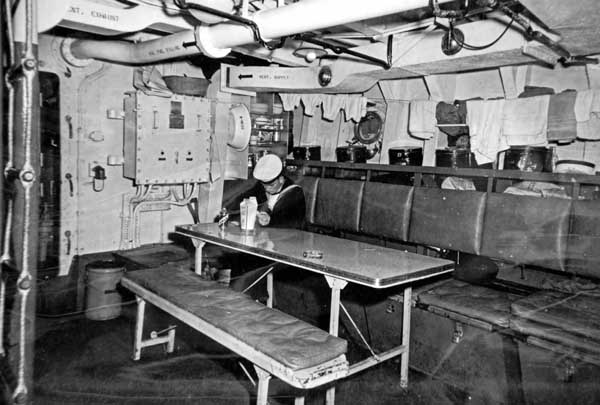 |
| This photo captures the essence of life in the messdeck of a Tribal class ship. (Haida Archives photo) |
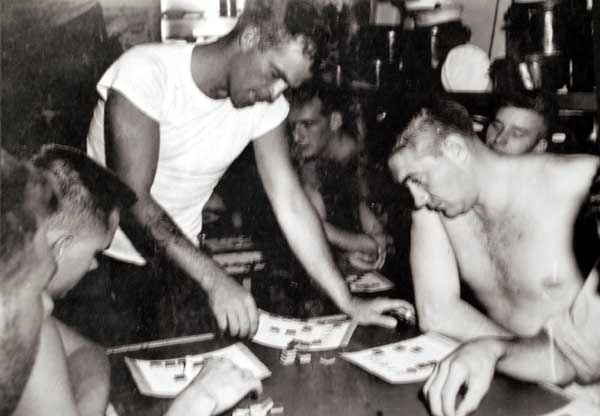 |
| The lower deck crew occupied some of their spare time with board games. Outgoing mail from the crew would be deposited in a mail slot in the ship's office. (DND photo) |
On the Mess Deck each of the tables represents a 'Mess' with eleven to twelve men grouped into a particular area. Along the sides of the Messdeck are grey, wooden lockers. These also doubled as Mess seating and were the only space that a sailor had for this clothing or 'Kit'. The Tribals were 'luxurious' in comparison to their predecessors according to a former seaman. Examples of this were: covers over light fixtures, padded seats in the Mess and the luxury of luxuries - a food warmer which kept food warm for those coming off watch. It had a great influence on improving morale.
 |
| This mockup, from HAIDA's Ontario Place era, interprets life in the Mess Deck. (Photo by Jerry Proc) |
 |
| Dish locker. (Photo by Jerry Proc) |
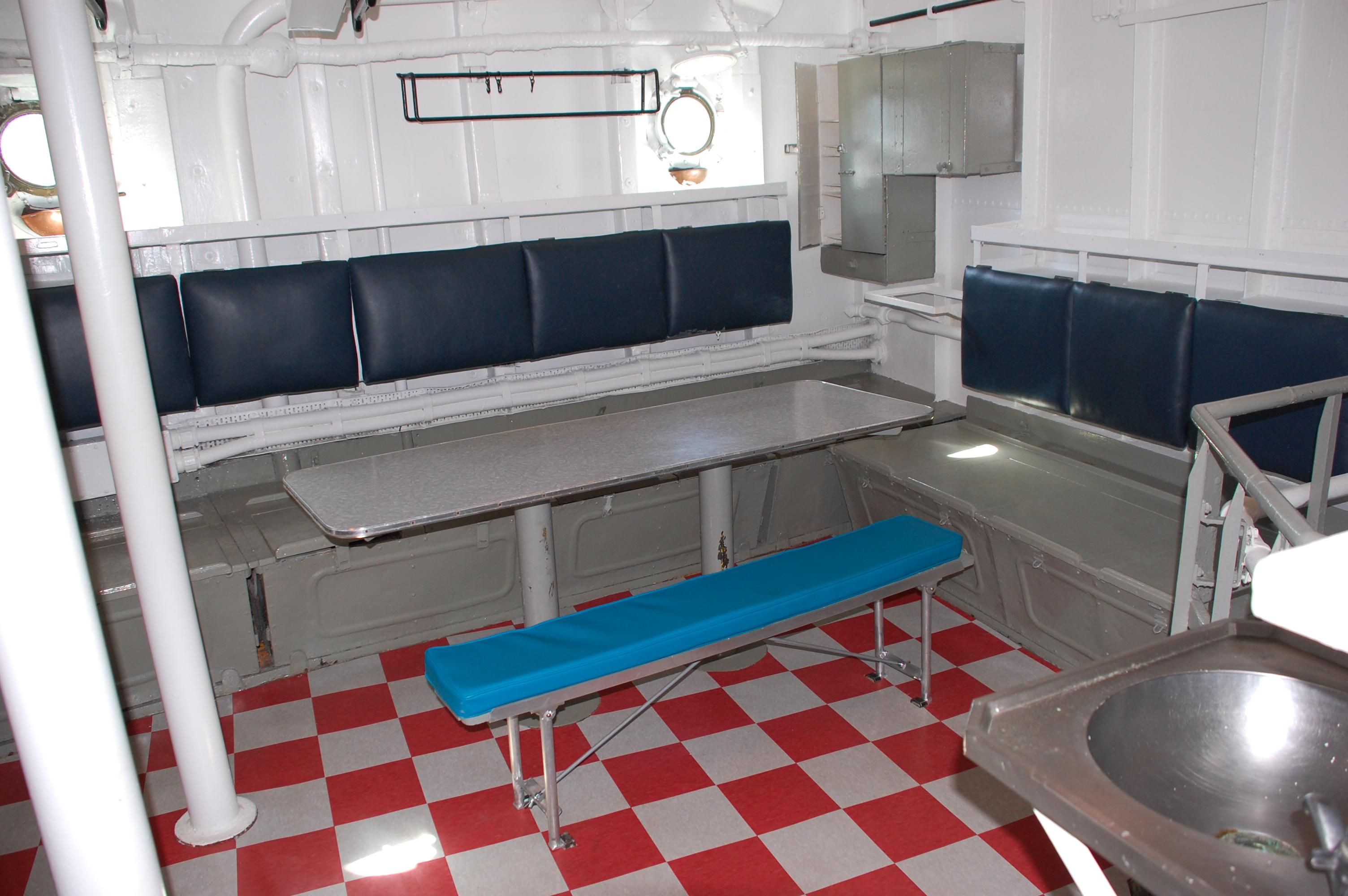 |
| Stewarts and cooks mess just aft of the Wardroom on the port side, (Photo by Jerry Proc) |
Gord Walker, who served in HMCS Micmac, provides this snippet of life in the Mess Deck. " I slung my hammock (aka mic) just outside the paint locker with the head extended over the "bin" that held the rolled-up hammocks when they weren't hung from the deckhead. Some of the others slung their mics over the mess tables and of course they were usually the last ones up. I remember quite often sitting down to breakfast only to have someone swing down from above, placing his foot onto my plate and watching the egg yolk squish up between his toes. Aboard Micmac we didn't have anything onboard to keep the food warm in the mess. With broadside messing it was always a challenge at sea to make it back to the mess without plastering your meal onto the bulkhead somewhere between the galley and the mess. We were lucky though - the guys in the forward lower mess had to navigate down a ladder with their plates! "Food provisions were stored under the after lower mess deck on the starboard side. The meat was stored n a freezer in the Fridge Flats under the forward lower mess deck. It is estimated that a Tribal had a provision supply of 14 to 30 days, depending on the duration of the voyage. When patrolling the English Channel, the ship would need fewer provisions than the Murmansk convoy run. Out on deck, on the port side across from the sea boat is a cage known as the "beef screen". Here, sides of beef were stowed and then butchered out on deck in the area forward of the sea boat. In the Royal Navy a Tribal's spirit locker was stocked with a 4 month supply.
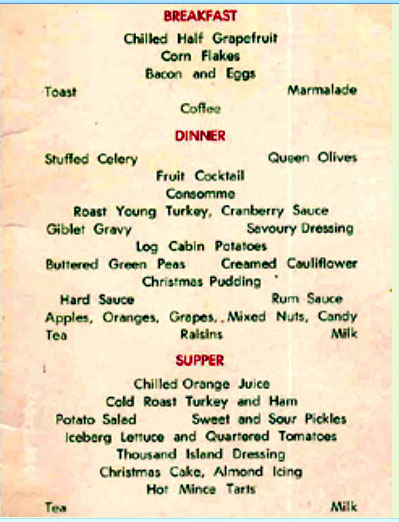 |
| So what did the sailors eat? This is the Chrimas 1953 menu from HMCS Algonquin and it's supposed to be an example of the type of food that the navy served their crews at this special time. |
In the September 1952 refit, an ice cream machine was fitted into HAIDA, There is a switch box above the Radio 1 battery case which says ICE CREAM . This may likely be the power source for the machine.
 |
| Beef screen: Out on deck on the port side and below the sea boat is a cage known as the beef screen. Here, sides of beef from the freezer were hung out to thaw, then butchered in the area under the sea boat. |
So how did they dispose of garbage while at sea? At the break of the focsle on both sides and the quarterdeck, there are four metal metal bars with two pegs – this was the connection point for a canvas chute which went below the water, so garbage could be thrown overboard and carried below the water, so it didn't float.
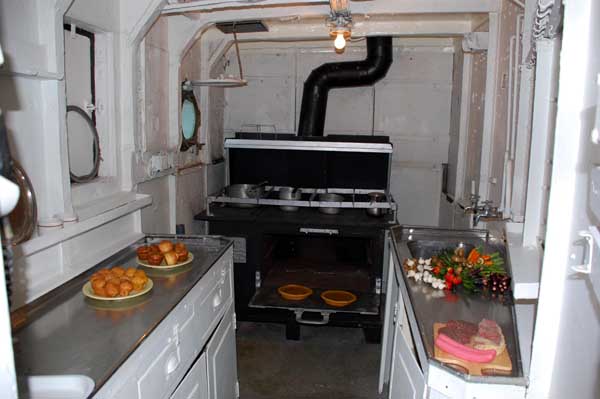 |
| Officer's and Captain's galley looking forward. |
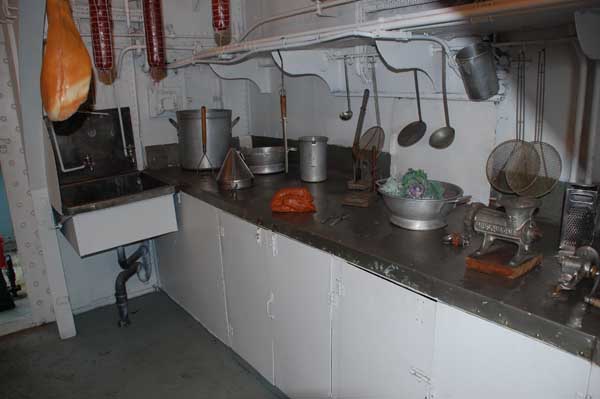 |
| Main Crew Galley - Looking forward and towards port. |
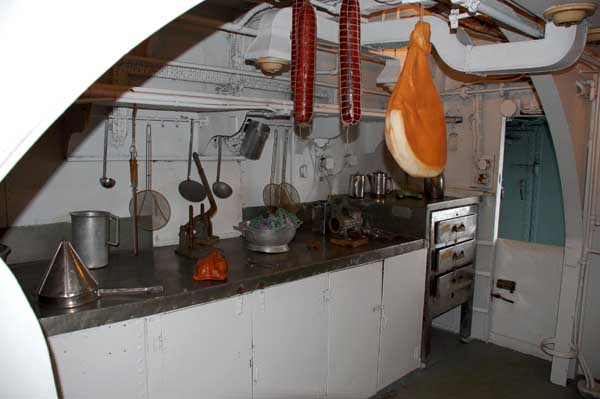 |
| Main Crew Galley - Looking forward and towards starboard. |
| All photos above by Jerry Proc |
BAKERY
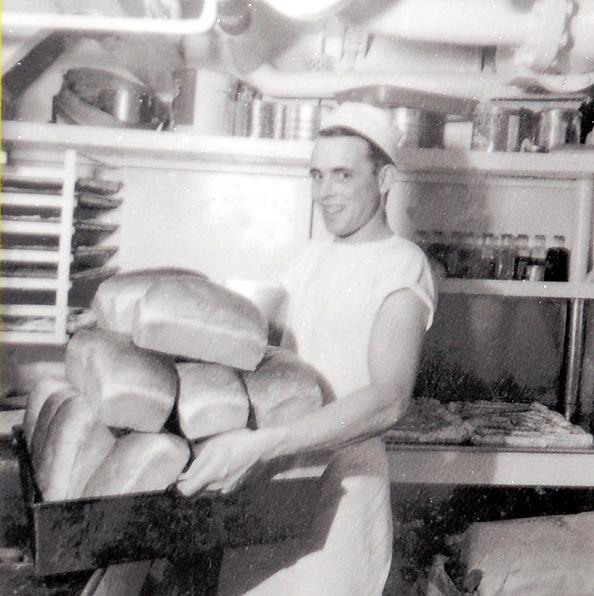 |
| Bakery: This is the compartment where the night cooks made bread and other baked goods for the ship's company . Bread, cakes and pies were baked then kept in the bread locker out on the main deck under canvas. (Library and Archives Canada/DND photo E004923310) |
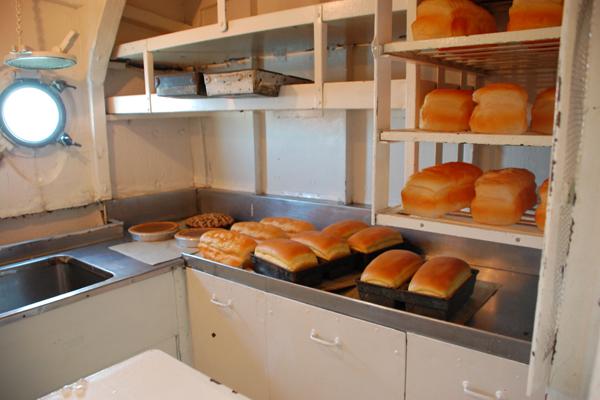 |
| The restored bakery as it looked in 2010. (Photo by Jerry Proc) |
| This was the ship's walk-in freezer. The evaporator coils are at the rear of the freezer. (Photo by Jerry Proc) |
Jan 1/25